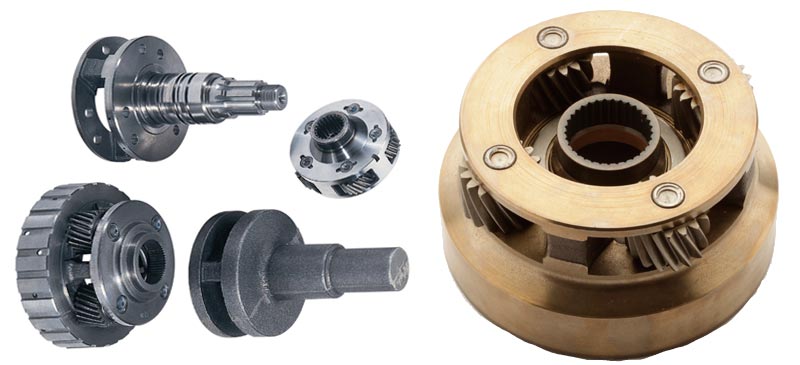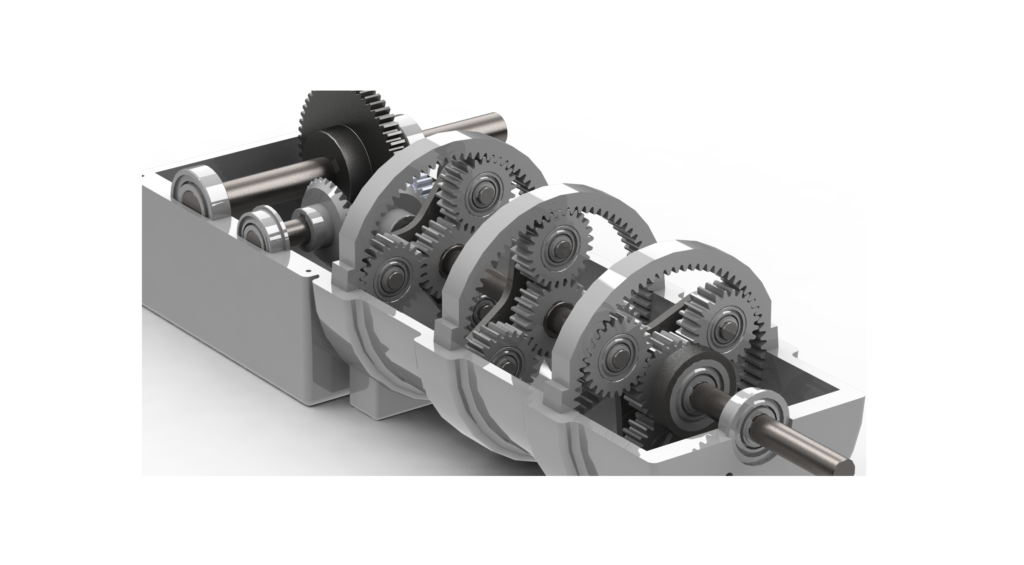Product Description
Planetary reduction drive servo gearbox single gear set sun epicyclic reduction micro motor epicyclic 2 stage single precision bevel stainless steel
Application of planetary gearbox
Planetary gearboxes are a type of gear reducer that uses a planetary gear train to transmit power. Planetary gear trains are characterized by their compact size, high efficiency, and ability to handle high torque loads. This makes them ideal for a variety of applications, including:
- Automotive: Planetary gearboxes are used in a variety of automotive applications, such as:
- Automatic transmissions
- Differentials
- Power steering
- Air conditioning compressors
- Machine tools: Planetary gearboxes are used in machine tools to provide smooth, quiet operation and to help to extend the life of the machine tools.
- Robotics: Planetary gearboxes are used in robots because they can provide the high torque and low backlash that is required for precise motion control.
- Aerospace: Planetary gearboxes are used in aerospace applications because they are lightweight, durable, and can withstand high temperatures.
- Wind turbines: Planetary gearboxes are used in wind turbines to convert the high-speed rotation of the turbine blades into a lower-speed rotation that can be used to drive a generator.
- Other applications: Planetary gearboxes are also used in a variety of other applications, including:
- Cameras
- Printers
- Scanners
- Medical equipment
- Food processing equipment
Here are some of the advantages of using planetary gearboxes:
- Compact size: Planetary gearboxes are typically smaller and lighter than other types of gear reducers, making them ideal for use in applications where space is limited.
- High efficiency: Planetary gearboxes are very efficient, typically achieving efficiencies of 95% or more.
- Low noise: Planetary gearboxes operate very quietly, making them ideal for use in applications where noise is a concern.
- Long life: Planetary gears are very durable and can last for many years under normal operating conditions.
- Ability to handle high torque loads: Planetary gearboxes can handle high torque loads, making them ideal for use in applications where high power is required.
Planetary gearboxes are a versatile type of gear reducer that can be used in a variety of applications. They offer a number of advantages over other types of gear reducers, including compact size, high efficiency, low noise, long life, and ability to handle high torque loads.
| Application: | Motor, Electric Cars, Motorcycle, Machinery, Marine, Toy, Agricultural Machinery, Car |
|---|---|
| Function: | Distribution Power, Clutch, Change Drive Torque, Change Drive Direction, Speed Changing, Speed Reduction, Speed Increase |
| Layout: | Three-Ring |
| Hardness: | Hardened Tooth Surface |
| Installation: | Torque Arm Type |
| Step: | Stepless |
| Samples: |
US$ 9999/Piece
1 Piece(Min.Order) | |
|---|

Can you explain how an epicyclic gear system handles torque distribution?
An epicyclic gear system, also known as a planetary gear system, is designed to handle torque distribution in an efficient and effective manner. Here’s a detailed explanation:
An epicyclic gear system consists of three main components: the sun gear, planet gears, and the ring gear. Each of these components plays a specific role in torque distribution:
1. Sun Gear:
The sun gear is the central gear in the system and receives torque input. It is typically connected to the power source, such as an engine or motor. The sun gear transfers torque to the other components of the system.
2. Planet Gears:
The planet gears are mounted on a carrier and rotate around the sun gear. They mesh with both the sun gear and the ring gear. The planet gears distribute torque between the sun gear and the ring gear, facilitating power transmission.
3. Ring Gear:
The ring gear is the outermost gear in the system and has internal teeth that engage with the planet gears. It is typically connected to the output shaft and transfers torque to the desired output, such as wheels in a vehicle or a generator in a wind turbine.
Here’s how the torque distribution works in an epicyclic gear system:
1. Torque Input:
The torque input is applied to the sun gear. As the sun gear rotates, it transfers torque to the planet gears.
2. Torque Distribution:
The planet gears receive torque from the sun gear and distribute it between the sun gear and the ring gear. Since the planet gears are meshed with both the sun gear and the ring gear, torque is transmitted from the sun gear to the ring gear through the planet gears.
3. Torque Multiplication or Reduction:
The torque distribution in an epicyclic gear system can be configured to provide either torque multiplication or torque reduction, depending on the arrangement of the gears. For example, if the sun gear is held stationary, the planet gears can rotate around the sun gear, causing the ring gear to rotate at a higher speed with increased torque. This configuration provides torque multiplication. Conversely, if the ring gear is held stationary, the sun gear can rotate, causing the planet gears to rotate in the opposite direction, resulting in torque reduction.
4. Even Torque Distribution:
An advantage of using an epicyclic gear system is that it facilitates even torque distribution among the planet gears. The multiple planet gears share the load, which helps distribute torque evenly across the gear system. This even torque distribution minimizes stress concentration on individual gear teeth, reducing wear and improving overall durability and reliability.
In summary, an epicyclic gear system handles torque distribution by transferring torque from the sun gear to the planet gears, which then distribute it between the sun gear and the ring gear. This configuration allows for torque multiplication or reduction and ensures even torque distribution among the planet gears, resulting in efficient power transmission and reliable operation.

What are the challenges associated with designing and manufacturing epicyclic gears?
Designing and manufacturing epicyclic gears, also known as planetary gears, can present several challenges. Here’s a detailed explanation:
1. Complex Geometry:
Epicyclic gears have a complex geometry due to the arrangement of multiple gears and the interactions between the sun gear, planet gears, and ring gear. Designing the gear profiles and ensuring proper gear meshing requires advanced mathematical calculations and modeling techniques.
2. Gear Tooth Profile Design:
The design of the gear tooth profiles is critical to ensure smooth and efficient gear operation. Achieving the correct tooth profiles, such as involute or cycloidal, requires precise calculations and considerations for factors like tooth strength, backlash, and clearance.
3. Load Distribution and Gear Sizing:
Determining the appropriate number of planet gears and their sizing is crucial for achieving proper load distribution. The load distribution affects gear durability and performance. Designers must carefully analyze the load distribution and consider factors such as torque, speed, and material properties to ensure optimal gear sizing.
4. Manufacturing Tolerances:
Epicyclic gears have tight manufacturing tolerances due to their complex geometry and the need for precise gear meshing. Achieving the required tolerances during the manufacturing process can be challenging and may require specialized equipment and techniques.
5. Assembly and Alignment:
Proper assembly and alignment of the gear components are crucial for achieving smooth gear operation and minimizing wear. Aligning the gears with high accuracy during assembly can be challenging, especially in large gear systems where multiple components need to be precisely aligned.
6. Lubrication and Cooling:
Epicyclic gears require effective lubrication and cooling to ensure optimal performance and durability. Designing proper lubrication systems and ensuring effective cooling in the gear system can be challenging, especially in applications where gears operate under high loads and speeds.
7. Noise and Vibration:
Epicyclic gears can generate noise and vibrations during operation, which can be undesirable in certain applications. Designing gears that minimize noise and vibration requires careful consideration of factors such as gear tooth profiles, gear meshing, and damping techniques.
8. Cost and Complexity:
Designing and manufacturing epicyclic gears can be cost-intensive and complex compared to simpler gear systems. The complexity of the gear geometry, manufacturing tolerances, and assembly requirements can contribute to higher production costs and increased manufacturing challenges.
In summary, the challenges associated with designing and manufacturing epicyclic gears include complex geometry, gear tooth profile design, load distribution and gear sizing, manufacturing tolerances, assembly and alignment, lubrication and cooling, noise and vibration, as well as cost and complexity. Overcoming these challenges requires advanced design and manufacturing techniques, precision engineering, and careful consideration of various factors to ensure optimal gear performance and durability.

How do epicyclic gears contribute to power transmission in machinery?
Epicyclic gears, also known as planetary gears, play a crucial role in power transmission within machinery. Here’s a detailed explanation of their contribution:
1. Gear Reduction:
Epicyclic gears allow for significant gear reduction, which is the process of reducing the rotational speed of the output shaft compared to the input shaft. By configuring the gear engagement and gear ratios, epicyclic gears can achieve high reduction ratios, enabling machinery to operate at lower speeds while maintaining high torque output.
2. Torque Multiplication:
Epicyclic gears also provide torque multiplication, which is the process of increasing the torque output compared to the torque applied at the input. By utilizing the gear ratios and gear arrangement, epicyclic gears can effectively multiply the torque, allowing machinery to generate higher rotational force for heavy-duty applications.
3. Compactness:
Epicyclic gears offer a compact design, making them ideal for applications where space is limited. The arrangement of the sun gear, planet gears, and annular gear allows for a high gear reduction or multiplication within a small footprint. This compactness is particularly advantageous in industries such as automotive, aerospace, and robotics, where efficient power transmission is required in confined spaces.
4. Versatile Gear Ratios:
Epicyclic gears provide a wide range of gear ratios, which allows machinery to adapt to different operational requirements. By selecting the appropriate combination of gear engagement and gear ratios, the speed and torque characteristics of the machinery can be tailored to specific applications. This versatility in gear ratios enhances the flexibility and performance of machinery across various industries.
5. Precise Control:
Epicyclic gears enable precise control over power transmission within machinery. The combination of rotational and orbital motion in planetary gear sets allows for smooth and precise adjustments of speed and torque. This level of control is crucial in applications that require accurate positioning, speed regulation, and responsive power transfer.
6. Multiple Functions:
Epicyclic gears offer various functions beyond power transmission. They can be utilized for directional changes, torque splitting, braking, and speed synchronization. These additional functions enhance the versatility and efficiency of machinery, allowing for complex operations and improved overall performance.
Overall, epicyclic gears contribute to power transmission in machinery by providing gear reduction, torque multiplication, compactness, versatile gear ratios, precise control, and multiple functions. Their unique design and capabilities make them a valuable component in a wide range of industries and applications.


editor by CX 2023-09-07